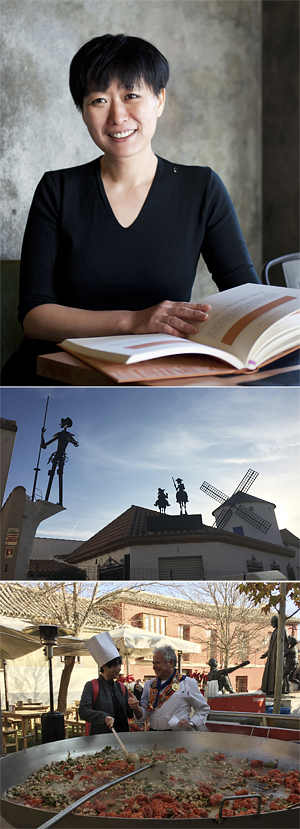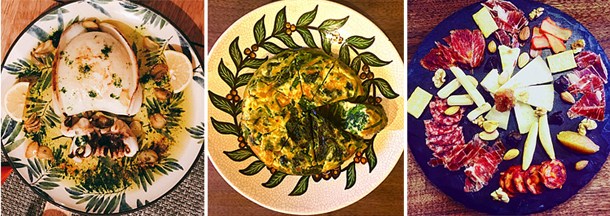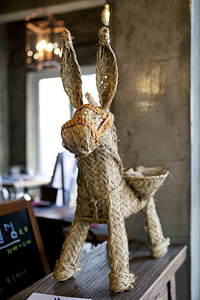Quixote-inspired trek turns writer into a chef : Novelist Cheon Un-yeong discovered a passion for Spanish cuisine and has opened a restaurant

Top: Korean novelist Cheon Un-yeong opened a Spanish restaurant after being inspired by foods that appear in “Don Quixote.” Middle: One of the places she explored is the La Mancha region, where the 1605 novel is set. Using Google Maps, she learned about dishes that have been made for over 400 years. Above: She explored the country for months to cook and she learned from the locals of various regions of the country. Seen here is Cheon learning to cook migas in Toledo. [JEON HO-SEONG, CHEON UN-YEONG]
“An olla of rather more beef than mutton, a salad on most nights, scraps on Saturdays, lentils on Fridays, and a pigeon or so extra on Sundays, made away with three-quarters of his income,” the first chapter of the book reads.
Korean novelist Cheon Un-yeong was staying in Malaga, Spain, in 2013 as part of a residency program. The 46-year-old was re-reading Don Quixote, which she first read when she was young and she became curious about the Saturday dish enjoyed by Don Quixote.
“In Spanish, it was written as ‘duelos y quebrantos’ which roughly translates as ‘duels and losses’ or ‘pain and suffering,’” she said. “I got curious and found out that it was the pork-based menu that the heathens, who did not eat pork, were forced to eat in order to avoid persecution by Spanish Christians under the so-called pure blood principle. They ate with tears in their eyes.”
She was amazed by how much history - a sad one - is in the mere name of a dish. As she kept reading, she realized that Don Quixote is a story about eating.
It describes in details what Don Quixote and Sancho Panza eat on their adventures; what kind of food was served at the banquet of a nobleman through which the writer introduces the times and the types of people living the era.
“It appeared to me that all of the foods that appear in the novel were the codes and the keys of understanding Don Quixote,” she said.
Cheon spent a year making the list of the dishes that appear in the novel and traveled across Spain to find them. That led to the opening of La Mesa del Quixote, a Spanish restaurant in Yeonnam-dong, western Seoul. Cheon is the owner and head chef of the restaurant.
Finding dishes from 400 years ago was a challenge. Using Google Maps, she drew up a list of all of the restaurants in the La Mancha region, went to their websites to comb through their menus. From there, she went to Zaragoza, and then to Barcelona and back to La Mancha.
She returned to Spain last year multiple times to learn how to cook Spanish cuisine. There were times when she cooked more than 100 dishes with the locals in a market in Madrid. At other times, she participated as an assistant to a teacher at a cooking class for foreign tourists.
“Before, I thought writing a novel was the hardest thing in life, but I learned being a chef is much harder,” she said in a recent interview with JoongAng Sunday conducted last month in her restaurant.
Cheon debuted in 2000 and her works include “Needle” (2001), “Goodbye, Circus” (2011) and “Ginger” (2011). Until now, she’s been writing without taking long breaks. But she says for now she’s all about the restaurant.
Cheon comes to the restaurant at 11 in the morning. She gets bread from a nearby bakery at noon. Between 3 and 4 in the afternoon, she prepares ingredients. Her mother, who was strongly against opening a restaurant, now comes to the restaurant everyday to help.
Here is an excerpt from the interview with Cheon about her mother, her fascination with Spain and challenges of running a restaurant and more.

From left: Grilled cuttlefish; Spinach tortilla; Spinach tortilla
A. I wouldn’t say I was a good cook, but I always loved cooking for people. When I was young, my father ran a factory. My mother cooked for the 20 to 30 employees there for ten years. She is from Suncheon, South Jeolla [known for good food] and she was a terrific cook. Even years later, some people would come, saying they came for my mother’s stew. Since elementary school, I was an assistant to my mother and earned pocket money for the work I did. When I was in college, I would invite my friends to my room and cook noodles. After I debuted as a novelist, I would serve fermented skate to my acquaintances.
You fermented skate on your own?
That’s what my family did all the time. Also I feel at ease the most when I am working on ingredients [for cooking]. For instance, when I experience writer’s block, I would remove excrement from anchovies or pound on blowfish. Right after I opened my restaurant, my friend sent me what I wrote after winning at an annual spring literary contest. My writing began “I wanted to be a cook.” I had totally forgotten about that. I thought maybe it was my destiny after all.
Still it wouldn’t have been an easy decision to open a restaurant. Was there a moment that cemented your determination?
After I came back from my six-month residency program in Spain, my dog that I had lived with for 15 years died. A day before it passed away, it seemed like it was in pain. I made a fried egg and mixed it with rice. The dog ate it all. After it died, I was in my room not being able to do anything. But then I thought, “at least it enjoyed the food I cooked,” and that was somewhat comforting to know. I guess that’s when I made up my mind to open a restaurant.

Cheon is getting support from the literary community, as seen from this straw donkey, a gift from cartoonst Chon Kye-young.
What’s so charming about Spanish food?
First of all, it’s cooked in a way that the ingredient’s original flavor is kept intact. Unless it’s necessary, it’s never over-cooked. Also, to the Spanish people, cooking is sharing. It’s just like how Koreans, in their difficult days, would cook gukbap [rice in soup] in a gigantic pot and share with all the neighbors. Spanish people also cook large quantities and share with neighbors. When I was learning to cook at a market in Madrid, whenever the class finished my teacher would pack me so much food. On my way home, I would share the food with the homeless.
The menu in your restaurant appears to be different from the usual menus we see at Spanish restaurants.
I added to the menu orange salad with cod and mussels with sherry wine that the Spanish people enjoy. Korean people are familiar with paella when it comes to the Spanish food, but I didn’t add it to the menu. In order to make a good broth to make paella, you bake ingredients like chicken, onions and bell pepper and boil for about 10 hours. You can use seasoning instead but I didn’t want to [fake] it.
Is there a dish from Don Quixote?
Not exactly, but a slightly altered item. A dish that uses bacon from the novel has been changed to use eggs. I also plan on introducing the lentil dish that’s in the novel soon.
I hear a lot of your friends from the literary community are helping out. Tell us about that.
Yes. [Novelists] Eun Hee-kyung, Pyun Hye-young and Kim Yeon-su are the biggest help. The donkey made of straw that guards the restaurant at the door is a gift from [cartoonist] Chon Kye-young. She got it from Spain. [Novelist] Yoon Sung-hee always tells me that she will wash dishes. She actually does that whenever she comes. In fact, many literary figures that I haven’t been able to keep in touch with visit. I am so happy I can serve them a meal.
Do you have any plans for a new novel?
For now, I am occupied [with the restaurant]. But I am publishing two books on Spanish culture and food. They are essays. I have embarked on an adventure like Don Quixote and I don’t know where the adventure will take me. When I go home after work at night, there are times when there are ideas in my head and I want to write.
When such desires add up to the point where it’s about to explode, maybe something will come out. When I come up with something amidst this adventure outside of the literary scene, maybe it will be something really meaningful.
BY LEE YEONG-HEE hkim@joongang.co.kr
"돈키호테 식단 연구하다 식당 차렸죠"
스페인의 대문호 미겔 데 세르반테스(Miguel de Cervantes?Saavedra, 1547~1616)가 1605년 발표한 소설 『돈키호테』는 라만차에 사는 이달고 돈키호테의 식단을 소개하며 시작한다. “그는 보통 양고기보다 쇠고기를 더 많이 넣은 요리와 소금을 넣어 잘게 다진 요리를 저녁으로 먹고 토요일에는 베이컨이나 햄 조각을 넣은?달걀?요리를, 금요일에는 납작한 콩 요리를, 일요일이면 새끼 비둘기 요리를 곁들여 먹느라 재산의 4분의 3을?지출했다.” (『돈키호테1』 65쪽,?열린책들)
2013년, 작가 레지던시 프로그램으로 스페인 말라가에 머물던 소설가 천운영(46)은 어릴 적 문고본으로만 봤던 『돈키호테』를 다시 읽기 시작했다가 첫 장에 나오는 돈키호테의 토요일 메뉴인 달걀 요리에 꽂혔다. “스페인어로 요리 이름이 ‘두엘로스 이 케브란토스(duelos y quebrantos)’라고 적혀있는 거예요. 사전을 찾아보니 ‘고뇌와 슬픔’이란 뜻이더라고요. 뭐지? 이게 음식 이름인가? 알고 보니 당시 기독교 순혈주의를 내세운 스페인에서 돼지고기를 먹지 않던 이교도들이 박해를 피하기 위해 울면서 먹어야 했던 음식이라고 하더라고요.”
놀라웠다. 음식 하나에 이런 비통한 역사가 담겨 있다는 사실이. 한 장 한 장 읽어내려가다 보니 『돈키호테』는 거대한 ‘먹는 이야기’였다. 세르반테스는 돈키호테와 산초가 모험 중에 어떤 음식을 먹었는지, 부자의 피로연에는 무슨 음식이 등장했는지 등을 상세하게 묘사하며 그 안에서 당시 시대상과 인간군상을 끌어낸다. 천 작가는 “책에 등장하는 음식들이 모두 당시 세르반테스가 남긴 암호고 열쇠고 비밀장부 같았다”고 했다. 꼬박 일 년에 걸쳐 책에 나오는 음식 목록을 작성하고, 그 음식을 찾아 스페인 곳곳을 누비기 시작했다. 지난해12월 서울 연남동에 문을 연 스페인 음식점 ‘라 메사 델 키호테(돈키호테의 식탁)’의 시작을 알리는 북소리였다.
천 작가는 이 레스토랑의 경영과 요리를 책임지는 ‘오너셰프’다. 지난 달 ‘돈키호테의 식탁’에서 만난 그는 “소설쓰는 게 제일 힘든 일인 줄 알았는데, 셰프가 훨씬 힘들더라. 그동안 내가 얼마나 안온하게 살아왔는지를 실감하고 있다”고 했다. 2000년 동아일보 신춘문예로 등단해 소설집 네 권(『바늘』 『명랑』 『그녀의 눈물사용법』 『엄마도 아시다시피』 )과 장편소설 『잘 가라, 서커스』 『생강』을 펴내며 꾸준히 글을 써 왔던 소설가가 갑자기 스페인 요리집이라니. 하지만 주변에선 “너 그럴 줄 알았다”는 반응이었단다.
질의 :원래 요리를 잘 했나보다.
응답 :“잘 한다기보단 사람들에게 뭔가를 만들어 먹이는 걸 좋아했다. 어릴 적 아빠가 공장을 했는데, 엄마가 20~30명쯤 되는 공장 직원들의 밥을 10년간 책임졌다. 전남 순천 출신인 엄마의 요리솜씨가 워낙 뛰어나 오랜 시간이 흐른 뒤에도 엄마표 찌개를 먹고 싶다고 찾아온 분이 있을 정도였다. 어릴 적부터 엄마 조수 역할을 하며 용돈을 받았다. 대학 때도 친구들을 자취방에 불러모아 비빔국수 해 먹이고, 소설가가 된 후엔 봄과 가을에 홍어를 삭혀 사람들 초대해 대접하고 그랬다.”
질의 :홍어를 직접 삭힌다니.
응답 :“우리 집에선 늘 하는 일이다. 나는 뭔가 식재료를 만지고 있을 때 가장 마음이 편하다. 소설이 잘 안 풀릴 땐 멸치똥을 바른다거나, 북어를 두들겨 보풀을 내곤 했다. 레스토랑을 연 직후에 친구가 2000년 신춘문예에 당선된 뒤 내가 썼던 소감을 보내줬다. 시작이 ‘나는 요리사가 되고 싶었다’다. 정작 나는 그런 글을 쓴 걸 까맣게 잊고 있었는데, 식당을 차릴 수 밖에 없는 운명이었던 건가 싶기도 했다.”
질의 :그래도 막상 결심하기가 쉽지 않았을 텐데.
응답 :“2013년 스페인에서 6개월을 보내고 돌아온 후 얼마 안 돼 15년을 함께 산 강아지가 죽었다. 죽기 전날 몸이 안 좋아보여 계란 프라이에 밥을 비벼주니 맛있게 먹더라. 개를 떠나보낸 후 일주일간 아무것도 못 먹고 방에 틀어박혀 있었는데, ‘그래도 내가 해 준 밥 맛있게 먹고 갔으니 다행이다’ 싶었다. 레스토랑을 해야겠다는 결심을 그때 했다.”
스페인 요리를 고른 건 물론 『돈키호테』 때문이었다. 책 속에 등장하는 400년 전 요리를 찾아내겠다는 건 “홍길동이 먹었던 콩나물 국밥을 찾아 팔도강산을 헤매는 것만큼” 무모한 일이었지만, 멈출 수가 없었다. 구글 지도에서 라만차 지역의 레스토랑을 샅샅이 찾아 홈페이지에 들어가 메뉴판을 검색했다. 라만차 지역에서 출발해 산초가 총독을 지낸 사라고사 인근과 바르셀로나를 거쳐 다시 고향으로 돌아오기까지. 스페인 전역을 3년에 걸쳐 오르락내리락했다. 맛을 보다보니 직접 만들어보고 싶었다. 지난해에는 3개월, 1개월, 3개월 단위로 나눠 스페인에 머물며 요리를 배웠다. 오전에는 마드리드의 시장 한복판에서 아줌마들과 100여 가지가 넘는 스페인 요리를 하고, 오후에는 '미국인 여행자들을 위한 빠에야 만들기' 등의 강좌에 요리 선생님의 조수로 참가했다.
질의 :스페인 요리가 매력적인 이유는?
응답 :“일단 재료의 맛을 최대한 살린다는 게 좋다. 꼭 필요한 것 이상의 조리는 하지 않는다. 또 스페인 사람들에게 요리는 ‘나눠먹는 것’이다. 한국인들이 고달픈 시절 큰 솥에 국밥을 끓여 함께 먹었던 것처럼, 스페인 사람들도 일단 많은 양의 음식을 푸짐하게 만들어 이웃과 나눈다. 마드리드 시장에서 요리를 배울 때, 수업이 끝나면 선생님이 음식을 잔뜩 싸줬다. 집으로 돌아오는 길에 만나는 노숙자들에게 음식을 나눠주곤 했는데, 그들이 ‘너무 맛있다’며 웃던 모습이 내게도 큰 힘이 됐다.”
질의 :메뉴가 일반적인 스페인 음식점과는 좀 다르다.
응답 :“스페인 사람들이 즐겨먹는 염장 대구와 오렌지 샐러드(살라다 데 나랑하 콘 바칼라오), 셰리주로 맛을 낸 조개술찜(메히요네스 알 헤레스) 등을 메뉴에 넣었다. 한국인들에게 제일 익숙한 건 빠에야인데, 일부러 넣지 않았다. 빠에야 육수를 제대로 만들려면 닭, 양파, 피망 등의 재료를 구운 후 10시간 정도를 푹 고아야 한다. 스페인식 조미료를 써도 되지만, 어설프게 하고 싶지는 않았다. 10명 이상이 참여하는 파티 음식으로만 대접하려고 한다.”
질의 :『돈키호테』에 나오는 음식도 맛볼 수 있나.
응답 :“그대로는 아니고 조금 변형했다. ‘두엘로스 이 케브란토스’는 베이컨 대신 새우와 버섯을 넣은 계란 요리로 바꿨고, 돈키호테가 금요일에 먹었던 살피콩 요리도 선보이려 한다.”
레스토랑을 시작한 지 한 달 반. 오전 11시면 가게에 나와 12시에 인근 제과점에서 빵을 받고, 3~4시부터는 재료를 손질한다. 너무 힘들어 두 번이나 링거 주사를 맞았고, 손등에는 깊은 화상을 입었다고 했다. 처음엔 음식점 여는 것을 강력하게 반대하던 어머니가 딸의 고된 일과를 보다 못해 이젠 매일 출근해 함께 조리대에 선다.
질의 :오너 셰프가 되어보니 어떤가.
응답 :“상상도 못할 정도로 힘들다. 해결해야 할 일이 예상의 몇 배 이상이다. 삶의 현장으로 내동댕이쳐져 보니 내가 그동안 소설가라는 이름으로, 문단의 보호 안에서 참 따뜻하게 살아왔다는 걸 알겠다.”
질의 :그래도 도와주는 친구들이 많다.
응답 :“은희경·편혜영·김연수 작가 등이 큰 힘이 되어 주었다. 식당 앞을 지키는 짚으로 만든 당나귀는 만화가 천계영이 직접 스페인에서 공수해 온 것이고, 윤성희 작가는 설거지를 책임지겠다더니, 진짜 올 때마다 주방에서 일을 한다. 성석제 선배, 이제하 교수님 등 오래 찾아뵙지 못했던 분들도 식당을 차린 덕분에 뵐 수 있었다. ‘소설 안 쓰고 뭐 하는 거냐’는 말을 들으면 민망하기도 한데, 그래도 이 사람들한테 밥 한 끼 내줄 수 있다는 게 그렇게 좋을 수가 없다.”
질의 :소설은 언제 다시 쓰려 하나.
응답 :“지금 소설을 쓸 여력은 없고, 스페인과 음식에 관한 에세이를 올해 두 권 내려 한다. 일단 돈키호테처럼 모험에 나섰고, 이 모험의 끝이 어딘지는 아직 모르겠다. 분명한 건 계속 글을 쓰기 위해 모험을 시작했다는 사실이다. 밤늦게 집에 돌아가면서 아이디어가 갑자기 떠올라 ‘아, 소설 쓰고 싶다’ 혼자 중얼거릴 때도 있다. 이 욕망이 계속 쌓이다 폭발할 지경이 되면, 내 안에서 뭔가 나오겠지. 문단의 보호 밖에서 새 소설을 내놓을 수 있을 때가 소설가 천운영의 또 다른 시작이라 믿는다.”
글 이영희 기자 misquick@joongang.co.kr 사진 전호성 객원기자










with the Korea JoongAng Daily
To write comments, please log in to one of the accounts.
Standards Board Policy (0/250자)